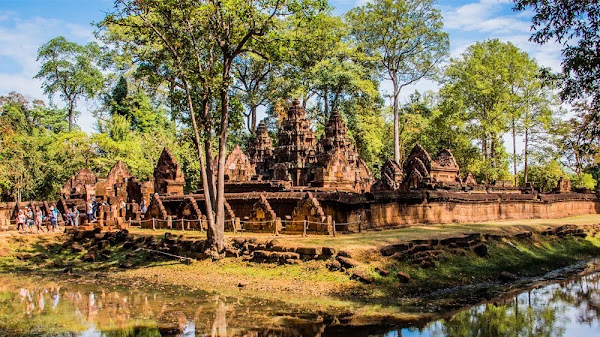Siem Reap, located in northwestern Cambodia, is a popular tourist destination in Asia due to its proximity to the ancient temples of Angkor. However, there's more to Siem Reap than just Angkor Wat. In this article, we'll explore the top 5 hidden gems in Siem Reap, Cambodia.
Siem Reap is a city in northwestern Cambodia, famous for its ancient temples, particularly the Angkor Wat temple complex. However, the city has much more to offer than just the temples. In this article, we'll explore the top 5 hidden gems in Siem Reap, Cambodia, that are worth a visit.
1. Banteay Srei Temple
Located 20 km northeast of Siem Reap, Banteay Srei Temple is a hidden gem that many visitors overlook. Built in the 10th century, the temple is dedicated to the Hindu god Shiva and is renowned for its intricate carvings and pink sandstone walls. The temple is smaller in size compared to other temples in Siem Reap, making it easier to explore and appreciate the intricate details of the carvings.
2. Tonle Sap Lake
Tonle Sap Lake is the largest lake in Southeast Asia and is located just outside Siem Reap. The lake is home to many floating villages where residents live on stilted houses and make a living by fishing. Visitors can take a boat ride to the floating villages and experience the local way of life. The boat ride also provides an opportunity to see a variety of birds and aquatic animals.
3. Kulen Waterfall
Kulen Waterfall, located 50 km north of Siem Reap, is a hidden gem that is worth the journey. The waterfall is located in the Phnom Kulen National Park and is a popular picnic spot for locals. Visitors can swim in the natural pool at the bottom of the waterfall and enjoy the serene surroundings.
4. Phnom Krom
Phnom Krom is a hill located 12 km southwest of Siem Reap that offers stunning views of the surrounding countryside. The hill is home to three ancient temples, all dedicated to the Hindu god Shiva. Visitors can climb to the top of the hill and explore the temples while enjoying the panoramic views.
5. Psar Leu Market
Psar Leu Market is a bustling local market in Siem Reap that is worth a visit. The market offers a variety of goods, including fresh produce, meats, and fish, as well as handicrafts and souvenirs. Visitors can experience the local culture and haggle with vendors to get a good deal.
Where to stay in Siem Reap
Siem Reap offers a variety of accommodation options to suit every budget, from backpacker hostels to luxury hotels. Some of the best areas to stay in Siem Reap are the Old Market Area, which is close to many of the city's main attractions, and the Riverside Area, which offers a more relaxed atmosphere.
What to eat in Siem Reap
Siem Reap is famous for its delicious Khmer cuisine, which is influenced by its neighboring countries Thailand and Vietnam. Some must-try dishes include Amok, a coconut milk-based curry made with fish or chicken and steamed in banana leaves, and Lok Lak, a stir-fry dish with marinated beef or chicken, served with rice and a dipping sauce. For a unique experience, visitors can also try fried insects such as crickets or tarantulas, which are considered a delicacy in Cambodia.
Getting around Siem Reap
Siem Reap is a compact city, and most of the main attractions are located within walking distance of each other. However, visitors can also rent bicycles or hire a tuk-tuk to get around the city. Tuk-tuks are a popular mode of transportation in Cambodia and offer a convenient and affordable way to explore the city.
Safety tips for Siem Reap
Siem Reap is generally a safe city for tourists. However, visitors should take precautions to ensure their safety, such as avoiding carrying valuables and money in crowded areas, especially at night. Visitors should also be aware of their surroundings and take precautions when using transportation, such as only using licensed taxis or tuk-tuks.
Conclusion
Siem Reap has much more to offer than just the Angkor Wat temples. With its hidden gems such as Banteay Srei Temple, Tonle Sap Lake, Kulen Waterfall, Phnom Krom, and Psar Leu Market, visitors can experience the local culture and natural beauty of Cambodia. From delicious Khmer cuisine to tuk-tuk rides through the city, Siem Reap is a must-visit destination for anyone traveling to Cambodia.
FAQs
-
What is the best time to visit Siem Reap?
The best time to visit Siem Reap is from November to February, when the weather is cooler and less humid.
-
Do I need a visa to visit Siem Reap?
Yes, visitors to Cambodia require a visa. Visitors can obtain a visa on arrival at the airport or border checkpoint or apply for an e-visa online before traveling.
-
How much does it cost to visit the Angkor Wat temples?
The cost of a one-day Angkor Wat temple pass is $37, a three-day pass is $62, and a seven-day pass is $72.
-
Is it safe to eat street food in Siem Reap?
Siem Reap has a vibrant street food scene, but visitors should exercise caution when eating street food to avoid food-borne illnesses. Look for busy stalls with freshly cooked food, and avoid raw or undercooked food.
-
What is the currency used in Siem Reap?
The official currency of Cambodia is the Cambodian Riel, but US dollars are widely accepted in Siem Reap, and it is advisable to carry US dollars in cash for most transactions.











0 Comments